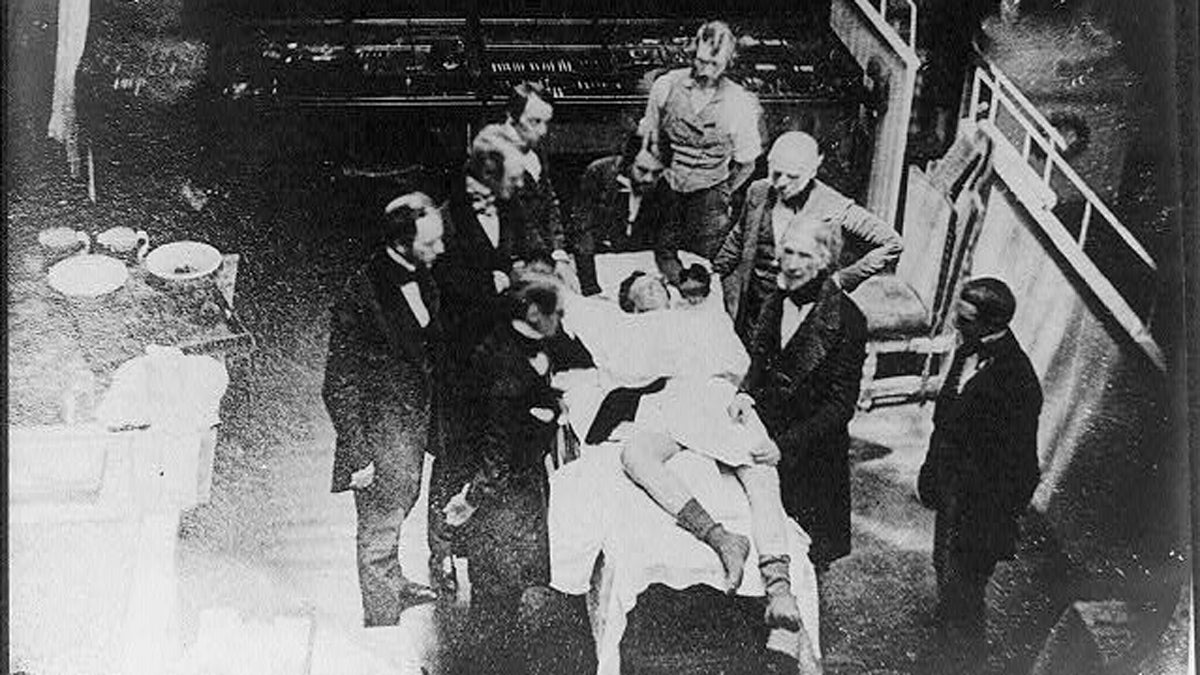Taking the pain out of surgery

Scene believed to be a re-enactment of the demonstration of ether anesthesia by W.T.G. Morton on October 16
Every day, the same scene plays out in thousands of hospitals around the world. A patient is wheeled into an operating room and prepped for surgery. A doctor places a mask over the patient’s face and instructs her to breathe deeply. A few minutes later, the patient is unconscious and the operation proceeds — quietly, deliberately, and above all, painlessly — thanks in no small part to a crucial demonstration that took place on October 16, 1846.
Prior to the 19th century, surgery was a messy and dangerous business. Even minor operations could inflict excruciating pain, and physicians could provide little respite for their patients beyond liquor or opium. However, in 1800, the British chemist Humphry Davy proposed an alternative solution. Davy was interested in “pneumatic chemistry,” a field of study that explored the properties of gases. Through firsthand experience, for example, he learned that breathing nitrous oxide induced a feeling of giddy euphoria, leading some to call it “laughing gas.” Davy also observed that nitrous oxide dulled the sensation of pain — an effect, he wrote, that “may probably be used with advantage during surgical operations.”
Davy never put this idea into practice. Instead, over the coming decades, breathing nitrous oxide became a form of entertainment. Romantic poets like Samuel Coleridge inhaled it at parties, and theatrical performers invited audiences to partake and release their inhibitions. It was at one such show in December 1844 that Hartford dentist Horace Wells first encountered nitrous oxide. He tried breathing the gas himself, but was more interested in the reaction of an acquaintance who hurt his knees while under its influence. Even as blood seeped through his pant legs, Wells’ friend remained blissfully unaware of the injury.
Realizing that nitrous oxide might eliminate the pain encountered in his dental practice, Wells decided to test the idea on himself. The next day he had one of his wisdom teeth removed while under the influence of the gas. As he noted afterwards, “I didn’t feel it so much as the prick of a pin!” Wells was quick to share his discovery and the following month was invited to Boston to demonstrate his technique at Massachusetts General Hospital. Unfortunately, his patient groaned during the course of surgery, leading the assembled doctors to deem Wells a fraud.
Disheartened, Wells retreated to Hartford, but not before discussing his work with a former business partner named William Morton. Morton, who had previously acquired a reputation as a speculator and con man, saw Morton’s invention as his ticket to fame and fortune. Following a conversation with physician Charles Jackson, he learned of another gas — sulfuric ether (later known as diethyl ether). Like Wells, Morton tested out the new gas on himself in Sept. 1846 and, after confirming its efficacy, contacted Massachusetts General Hospital. On Oct. 16, crowds gathered again in the hospital’s operating theater and watched Morton administer ether to a young man named Gilbert Abbott. John Warren — the dean of Harvard’s medical school — proceeded to remove a tumor from Abbott’s neck. When Abbott awoke from surgery he reported feeling no pain, only a dull scraping against his skin. “Gentlemen,” Warren reportedly told the assembled audience, “this is no humbug.”
Morton rushed to patent the use of ether during surgery and spent the rest of his life claiming to be the father of what physician-turned-poet Oliver Wendell Holmes termed “anesthesia.” In fact, he was neither the first to formulate the idea of using a gas to inhibit surgical discomfort nor the first to use ether for that purpose — Georgia physician Crawford Long actually tested out the idea in 1842. But Long only published his findings in 1849 — three years after Morton’s demonstration had won over the medical establishment. By that point, doctors in America and Europe had embraced the use of ether and the promise of surgery without pain. Indeed, thanks to anesthesia, patients today are more likely to wake up crying after their surgery than during it.
WHYY is your source for fact-based, in-depth journalism and information. As a nonprofit organization, we rely on financial support from readers like you. Please give today.



